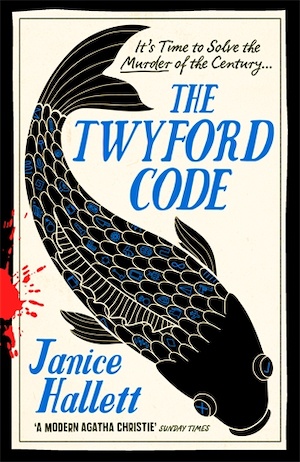
After exposing the machinations within an amateur dramatics group in her bestselling debut novel The Appeal, Janice Hallett turns her attention to the sinister side of classic children’s literature in The Twyford Code. While Hallett revamped the epistolary novel format with The Appeal by telling the story entirely through texts, emails and other documents, she has innovated further with The Twyford Code and written a compelling mystery with a tone strangely reminiscent of Golden Age crime novels principally using transcriptions of 200 audio files recorded on an old iPhone by ex-con Steven Smith.
Around 40 years ago, Steven found a copy of Six on Goldtop Hill by Edith Twyford on a London bus and, hoping to be able to sell it for money to buy a chippie tea, took it to school with him. Not exactly a natural scholar, the only class that Steven quite liked was remedial English, which was taught by the unusually charismatic Miss Isles – or ‘missiles’ as the transcription software maintains. According to Miss Isles, Twyford’s books had been banned due to being “nasty, sadistic, moral little tales full of pompous superiority at best and blatant racism at worst”. As Steven was unable to read the book himself, he had to take Miss Isles’ word for it when she claimed there was a note inside saying “Deliver to Alice Isles” and confiscated it.
Nevertheless, due to the interest that Steven and the other four students in her remedial English class showed in studying a banned book, Miss Isles dedicated some lesson time to reading passages from Six on Goldtop Hill, and here Hallett delivers some delightfully funny pastiches of the most sexist aspects of Enid Blyton’s oeuvre. It turned out that Miss Isles was actually quite the expert on Twyford, particularly the conspiracy theory that alleged the writer had used her books to send secret coded messages to the enemy during World War II.
Whether due to her own interest in cracking the so-called Twyford code or in an attempt to enhance her students’ learning experience, Miss Isles took the five of them on an unauthorised field trip to Bournemouth to visit the cottage that Twyford had lived in during the war. As the early audio recordings make clear, Steven remembers going on the trip and he remembers arriving home very late at night, but he can’t remember what actually happened throughout the day. The only thing he’s sure of is that he never saw Miss Isles again.
In the present day, having recently been released following a long stretch in prison, as Steven records messages to his probation officer Maxine, he explains about the mysterious disappearance of Miss Isles and muses about his missing memories while also explaining his current situation. He dropped out of school following the fateful field trip and fell in with the powerful Harrison family, which started him on the path to a life of crime. Determined to avoid going back to prison and hoping to reconnect with his son, Steven informs Maxine that he has decided to investigate Miss Isles’ disappearance and discover whether there is any truth to the story of the Twyford code.
From this point on, Steven records the progress of his investigation, interviewing those he thinks can help him and attempting to draw conclusions based on what he learns. As his transcription software is not very reliable, there are a number of repeated malapropisms (or are they?) and it can sometimes be difficult to distinguish who is speaking. When combined with Steven’s own confusion and patchy recollections, such glitches in the transcripts lend the story a rather disordered tone, which reflects well both the unlikely nature of the central conspiracy theory and the high likelihood of unreliable narration due to the passage of years and the difficulty of confronting troubling memories.
This storytelling device also allows Janice Hallett to explore how different people, particularly Steven, Nathan, Donna, Shell and Paul from Miss Isles’ class, remember the same events differently, and what that might mean in terms of Steven actually getting to the truth. Despite (or, perhaps, because of) his troubled background and criminal history, Steven is a great and big-hearted character. His musings are insightful, sometimes heartrending and often amusing, especially his interpretations of the activities of the Super Six, Edith Twyford’s main characters.
Having learned to read while in prison, Steven is finally able to tackle Twyford’s books for himself and can examine Miss Isles’ claims about a secret code spread across their pages, while also investigating her disappearance. Hallett’s use of codes and puzzles throughout The Twyford Code is enthralling. The tight plotting allows for the central Twyford code to shift and develop as Steven’s investigation progresses and he learns more about both Twyford and Miss Isles. He’s assisted in unravelling the various threads of the main puzzle by young librarian Lucy, who provides helpful exposition and contributes knowledge concerning art and literature that proves necessary to move things along. The relationship between Steven and Lucy has a nice dynamic and helps to highlight both his softer side and his intelligence.
The Twyford Code is a fiendishly clever puzzle mystery packed with plenty of twists and turns and probably more than its fair share of red herrings. Miss Isles’ disappearance is a perplexing affair, while the idea of Edith Twyford passing coded messages to the Nazis via twee children’s books is a bonkers yet engaging concept. As a whole, the story offers an engrossing and challenging conundrum for you to puzzle out.
If you like the sound of The Twyford Code, you might also enjoy Richard Osman’s The Man Who Died Twice or one of the Six Stories novels by Matt Wesolowski.
Viper
Print/Kindle/iBook
£6.29
CFL Rating: 5 Stars